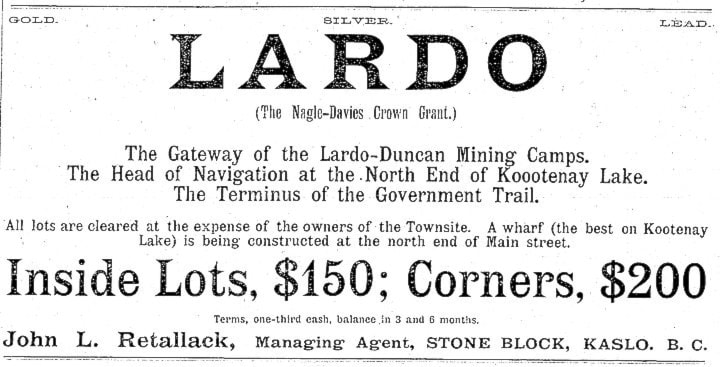One-hundred thirteenth in a semi-alphabetical series on West Kootenay/Boundary place names
While the origin of Lardo/Lardeau is shrouded in mystery, there was a battle for the right to use it between two similarly named towns: Lardo (or Lardo City) on Kootenay Lake, and Lardeau (or Lardeau City), on the northeast arm of Upper Arrow Lake.
The latter was first mentioned in Revelstoke’s Kootenay Star on Aug. 13, 1892: “We hope the boys at the ‘Lardeau City’ will return the compliment we paid them on the 1st of July.”
Details of the townsite survey are unknown, but the plan was apparently deposited with the land registry on Dec. 2, 1892 by William Harrington Ellis, editor and part owner of the Victoria Colonist. Ellis was also one of the principals of the Lardeau and Kootenay Railway, which wanted to build a line that would connect Lardo and Lardeau, although nothing came of it.
James (Pothole) Kellie, MLA for the region, was another key Lardeau City booster.
The same month, Charles W. Busk surveyed the Lardo townsite. The streets were Lardo, Duncan, Kootenay, Dawson, Kaslo, Main, and South, while the avenues were numbered 1st through 6th. (Today only Main, Duncan, and Kootenay streets survive, along with 3rd, 4th, and 5th avenues.)
The town was first mentioned in the Nelson Tribune of Dec. 1, 1892: “C.W. Busk is surveying the Nagle-Davies townsite at the head of Kootenay Lake and expects to have the job completed within two weeks. The town will be called Lardo and lots will be placed on sale as soon as the survey is completed …”
(There might have been another Lardeau City around this time too, judging from this item in the Spokane Review of Nov. 26, 1892: “At the confluence of the [Lardeau and Duncan rivers] a town has lately been platted and christened Lardeau City.” A.C. Pearson ran the Valley House hotel at this spot in 1893, which was otherwise known as Pearson’s or Garden Valley. The latter is first mentioned in the Kaslo Slocan Examiner of May 13, 1893 and the former in the Nelson Tribune of April 14, 1894. Meanwhile, the town of Ferguson was initially called Lardeau Forks, according to the 1897 Henderson’s BC directory.)
The towns butted heads when the Lardo townsite map was presented at the land registry in January 1893 and the registrar refused to accept it because the name was too similar to Lardeau. The owners appealed to the courts, but the judge dismissed the case: “I think the registrar is right in refusing to register a second map with a name identical in sound with another name already on the register.”
Lardo’s promoters nevertheless found a way to register their townsite. Nor did the conflict deter both towns from applying for post offices, first Lardo and then Lardeau.
BC postal inspector E.H. Fletcher supported the former’s application: “The population of Lardo is much larger and more important than that of Lardeau and the former being the first in the field for a post office, should I think, have the advantage of their enterprise.”
However, Fletcher’s superiors would only authorize the post office at Lardo providing the name was changed. (They were under the mistaken impression an injunction had been issued preventing use of Lardo.)
Each town felt it had an exclusive right to the name and insisted it would be impossible to find an alternative. They began trading insults. An editorial in the Lardo Reporter called Lardeau “a mathematical point on the Arrow Lakes, occupying position but no space [which] has not yet fulfilled its manifest destiny by becoming a sheep ranch ...”
Lardeau criticized its rival’s geography: “Lardo claims to be entitled to the name because of its proximity to the mouth of the Lardo River. It is some 35 miles form its mouth.” It also took out ads stating “The only Lardeau! None genuine without the ‘deau’ in the name.”
MP John Mara was asked to intervene but decided to sit on the fence: “I unfortunately promised to support the application for offices at both places, not knowing that the department would object on account of the similarity of names.”
Lardo’s promoters suggested “Lardo, Kootenay Lake” and “Lardeau City, Arrow Lake” would be distinctive enough, but the post office disagreed.
Postmaster-general William White finally ruled: “The question of name must be settled by the parties themselves.” With neither side willing to compromise, the matter remained unresolved.
In October 1893, E.H. Fletcher’s assistant visited Kaslo and inquired about Lardo: “He ascertained that the place is now practically deserted ... There is therefore no necessity for the establishment of a post office at Lardo during the coming winter.”
Next: Lardo, Idaho
Previous installments in this series
Applegrove, Appleby, and Appledale revisited
Bakers, Birds, and Bosun Landing
Bannock City, Basin City, and Bear Lake City
Bealby Point (aka Florence Park) revisited
Boswell, Bosworth, Boulder Mill, and Broadwater
Brooklyn, Brouse, and Burnt Flat
Camborne, Cariboo City, and Carrolls Landing
Carmi, Cedar Point, Circle City, and Clark’s Camp
Carson, Carstens, and Cascade City
Christina City and Christian Valley
Cody and Champion Creek revisited
Champion Creek revisited, again
Columbia City, Columbia Gardens, and Columbia Park
Crawford Bay and Comaplix revisited
Dawson, Deadwood, and Deanshaven
English Cove and English Point
Forslund, Fosthall, and Fairview
Fort Shepherd vs. Fort Sheppard, Part 1
Fort Shepherd vs. Fort Sheppard, Part 2
Gladstone and Gerrard, revisited
Granite Siding and Granite City
Hall Siding and Healy’s Landing
Hudu Valley, Huntingtdon, and Healy’s Landing revisited
Inonoaklin Valley (aka Fire Valley)
Jersey, Johnsons Landing, and Jubilee Point
Kootenay Bay, Kraft, and Krestova
Kuskonook (and Kuskanax), Part 3
